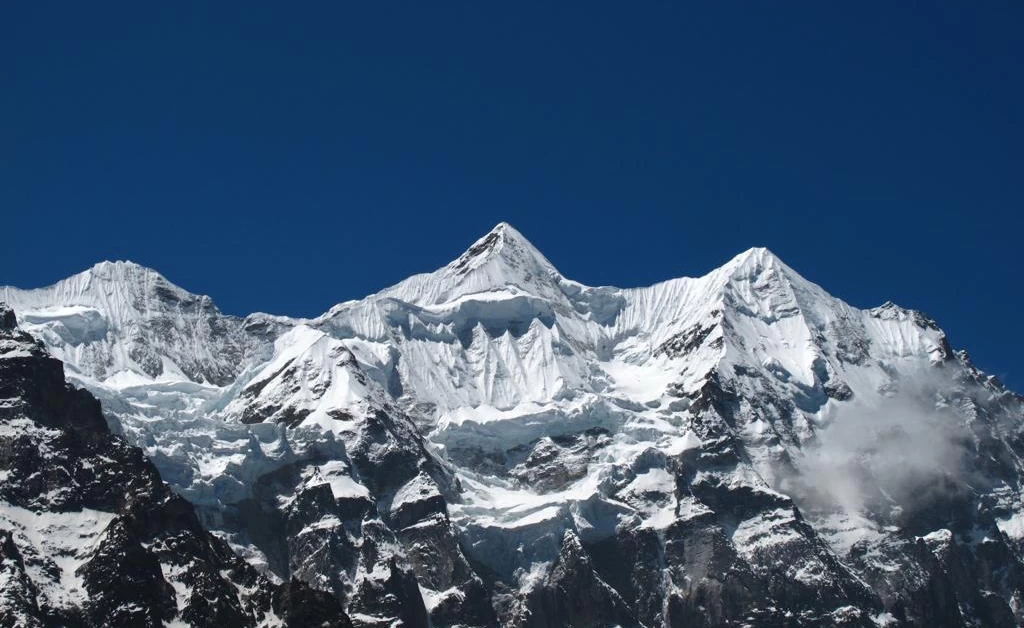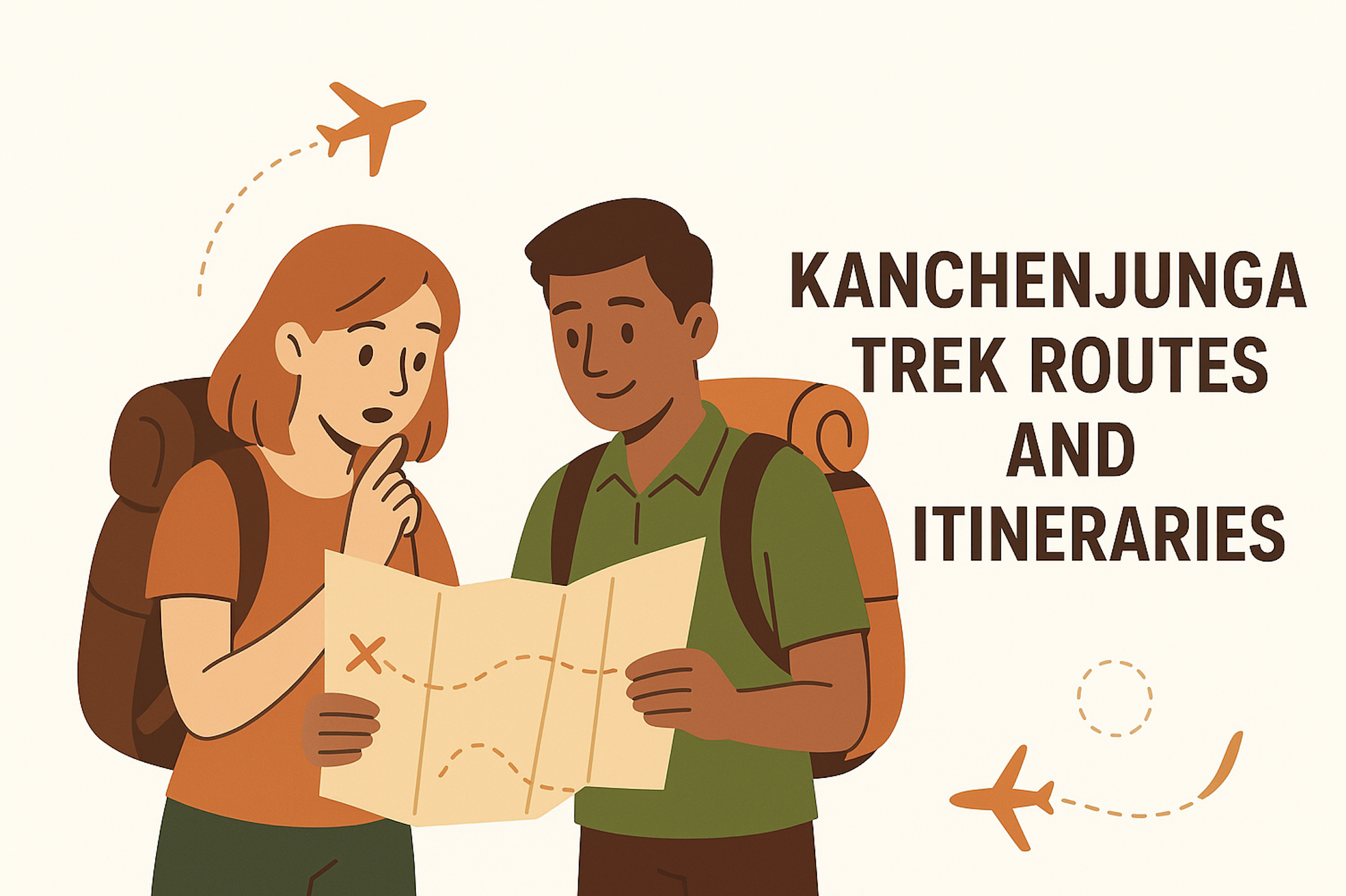Introduction of Kanchenjunga Trek

he Kanchenjunga Trek is one of Nepal’s most thrilling and off-the-beaten-path adventures, taking you deep into the untouched wilderness of the eastern Himalayas. This trek leads you to the majestic Kanchenjunga, the world’s third-highest mountain at 8,586 meters, offering some of the most spectacular mountain views in the world. This journey leads through pristine landscapes, hidden valleys, and quiet villages that few travelers ever experience. Towering snow-capped mountains, glacial streams, and dense forests create a stunning backdrop for an adventure into the heart of eastern Nepal.
This trek offers two main options: the Kanchenjunga Base Camp Trek and the Kanchenjunga Circuit Trek. The base camp route brings trekkers close to glaciers and the towering Kanchenjunga peaks, offering intimate, breathtaking views. The circuit trek, slightly longer and less frequented, loops around the Kanchenjunga massif. Often considered a more challenging journey, it usually takes 20–25 days to complete. Its remoteness, rugged trails, and limited facilities make it perfect for those seeking an adventurous, off-the-beaten-path experience.
Walking through this region reveals a mix of natural wonders and cultural richness. Trekkers pass through rhododendron forests, alpine meadows, and terraced fields, and may catch glimpses of unique Himalayan wildlife. Small mountain settlements along the trail provide an opportunity to interact with the Limbu, Rai, and Sherpa communities, offering a chance to witness traditional lifestyles, enjoy local food, and experience the warmth of Himalayan hospitality.
Each day presents new sights: sparkling glacial streams, hidden waterfalls, and panoramic views of Kanchenjunga and neighboring peaks. Nights spent in cozy tea houses or mountain lodges offer rest and comfort, preparing trekkers for the next day’s adventure.
Challenging yet immensely rewarding, the Kanchenjunga Trek combines spectacular scenery, cultural encounters, and the serenity of untouched nature. For those seeking a rare Himalayan adventure, far from crowded trails, this journey provides unforgettable memories of Nepal’s eastern wilderness and the majestic Kanchenjunga region.
Kanchenjunga Trek Highlights and Major Area
The Kanchenjunga region offers a journey into one of Nepal’s most remote and unspoiled Himalayan landscapes, combining natural beauty, culture, and adventure in a single trek.
- Majestic Mountains and Panoramas
Trekkers witness Kanchenjunga (8,586 m) towering above the horizon, alongside peaks like Janu Himal, Kumbhakarna, and Makalu. The ever-changing scenery—from green lower hills to snow-blanketed summits—makes every step rewarding. Sunrise and sunset views over these peaks create moments of sheer awe, leaving lasting impressions.
- Secluded Trails and Wilderness
Far from busy trekking routes, the trails wind through dense forests, alpine meadows, and hidden valleys, providing a sense of isolation and tranquility. Glacial streams, waterfalls, and rocky ridges appear along the path, allowing trekkers to enjoy nature at its most raw and untouched form.
- Local Culture and Villages
The trek passes through small settlements inhabited by Limbu, Rai, and Sherpa communities. Visitors get a chance to see traditional homes, taste local dishes, and engage with the community’s lifestyle and customs. These interactions create a deeper connection with the region beyond its scenic beauty.
- Challenging Circuit Trek
The Kanchenjunga Circuit Trek, taking 20–25 days, loops around the massif for a more immersive experience. Its rugged trails, high-altitude passages, and remote locations make it one of the most adventurous treks in Nepal. The route requires stamina, but it rewards trekkers with solitude and breathtaking views rarely found on more popular trails.
- Flora and Wildlife
The region hosts a variety of plant and animal life. Spring brings vibrant rhododendron blooms, while the alpine areas feature rare high-altitude flora. Wildlife such as Himalayan tahr, red pandas, and colorful birds adds another layer of excitement to the journey.
- Rest Stops and Tea Houses
Even in this remote region, trekkers find small tea houses and mountain lodges, offering warm meals, comfortable beds, and a chance to relax after long days on the trail. These simple accommodations add to the authentic experience of mountain life.
- Hidden Valleys and Glacial Streams
The trek passes through serene valleys and clear glacial streams, perfect for quiet reflection and nature photography. These spots, tucked away from common trekking routes, highlight the untouched charm of the Kanchenjunga region.
Geographical and cultural Significance of Kanchenjunga Trek
The Kanchenjunga Trek winds through one of Nepal’s most remote and breathtaking regions, where towering peaks, hidden valleys, glacial streams, and vibrant alpine meadows create a landscape of extraordinary natural beauty. This journey not only offers stunning views of the world’s third-highest mountain but also immerses trekkers in the rich cultures of the Limbu, Rai, and Sherpa communities, who have preserved their traditions, festivals, and ways of life for generations. The region’s isolation has allowed both nature and culture to thrive undisturbed, making each step a blend of adventure, serene wilderness, and authentic Himalayan heritage a rare experience that touches the heart as much as it challenges the body.
Kanchenjunga Trek Routes and Itineraries
Planning your Kanchenjunga trek? Let us handle the arrangements and make your journey with INFO NEPAL TOURS AND TREAKS PVT.LTD

Kanchenjunga Trek – 22 Days Itinerary
Day 1: Arrival in Kathmandu
Arrive in Kathmandu, meet your trekking guide, check your trekking gear, and prepare for the journey ahead. Overnight in Kathmandu.
Day 2: Kathmandu – Taplejung
Fly or drive to Taplejung, explore the town, and get ready for the trek. Overnight in Taplejung.
Day 3: Taplejung – Lekhpharsa
Trek through scenic trails, passing small villages and farmland. Cross streams and enjoy mountain views. Overnight in Lekhpharsa.
Day 4: Lekhpharsa – Amjilosa (Trek: 5–6 hrs)
Trek through forested trails along rivers. Cross small suspension bridges and enjoy local villages. Overnight in Amjilosa.
Day 5: Amjilosa – Tapethok (Trek: 5–6 hrs)
Walk through rhododendron and oak forests with occasional open viewpoints. Experience peaceful village life along the trail. Overnight in Tapethok.
Day 6: Tapethok – Yamphudin (Trek: 5–6 hrs)
Enter the Kanchenjunga Conservation Area and trek through lush forests. Pass remote settlements and terraced fields. Overnight in Yamphudin.
Day 7: Yamphudin – Tortong (Trek: 6–7 hrs)
Climb steadily through valleys with panoramic mountain views. Interact with local Limbu and Rai communities. Overnight in Tortong.
Day 8: Tortong – Amjilosa (Trek: 6–7 hrs)
Descend through forests and along rivers. Enjoy peaceful surroundings and scenic landscapes. Overnight in Amjilosa.
Day 9: Amjilosa – Tseram (Trek: 5–6 hrs)
Trek through quiet valleys and small settlements. Capture distant views of Kanchenjunga peaks. Overnight in Tseram.
Day 10: Tseram – Khangpachen (Trek: 5–6 hrs)
Gradually ascend through alpine meadows and dense forests. Spot local wildlife and enjoy fresh mountain air. Overnight in Khangpachen.
Day 11: Khangpachen – Kanchenjunga Base Camp (Trek: 6–7 hrs)
Follow a steep trail leading to the base of Kanchenjunga. Witness glaciers, mountain peaks, and breathtaking scenery. Overnight at Base Camp.
Day 12: Explore Kanchenjunga Base Camp
Rest and explore the surrounding area. Take short hikes for photography and enjoy the high-altitude environment. Overnight at Base Camp.
Day 13: Kanchenjunga Base Camp – Khangpachen (Trek: 6–7 hrs)
Begin descending back through alpine meadows and forests. Relish the views of glaciers and peaks on the way. Overnight in Khangpachen.
Day 14: Khangpachen – Tseram (Trek: 5–6 hrs)
Continue descending along forest trails. Pass small villages and rivers on your way. Overnight in Tseram.
Day 15: Tseram – Amjilosa (Trek: 6–7 hrs)
Trek down through scenic valleys. Enjoy peaceful forests and terraced fields along the path. Overnight in Amjilosa.
Day 16: Amjilosa – Yamphudin (Trek: 6–7 hrs)
Walk back through small villages and farmland. Experience local culture and natural scenery. Overnight in Yamphudin.
Day 17: Yamphudin – Tapethok (Trek: 5–6 hrs)
Trek through forests and cross small streams. Enjoy the calm environment and village life. Overnight in Tapethok.
Day 18: Tapethok – Lekhpharsa (Trek: 5–6 hrs)
Descend gradually along forested trails. Pass streams and small settlements. Overnight in Lekhpharsa.
Day 19: Lekhpharsa – Taplejung (Trek/Drive: 4–5 hrs)
Trek to Suketar, then drive or fly back to Taplejung. Rest and prepare for return journey. Overnight in Taplejung.
Day 20: Taplejung – Kathmandu
Fly or drive back to Kathmandu. Enjoy the city and relax after trekking. Overnight in Kathmandu.
Day 21: Kathmandu Sightseeing
Visit Pashupatinath, Boudhanath, Patan Durbar Square, and local markets. Experience Nepali culture and cuisine. Overnight in Kathmandu.
Day 22: Departure from Kathmandu
Transfer to the airport for your flight home, marking the end of your Kanchenjunga adventure.
Cost for Kanchenjunga Trekking

The cost of our Kanchenjunga Trek package ranges from USD 1,800 to 2,100, varying according to the group size and trek duration.
Organizing a Kanchenjunga trek requires careful planning and consideration of several factors. You’ll need to account for meals, lodging, transportation, trekking equipment, and other essential supplies, all of which contribute to the overall cost.The journey also comes with its share of difficulties and challenges, so it’s important not to underestimate your budget. The total expense of the trek largely depends on how long you spend in the region.Daily costs can fluctuate depending on your travel preferences and the places you choose to visit. On average, it’s advisable to allocate between USD $2,000 and $2,500 per person. Opting for upgraded services, such as comfortable accommodations with modern amenities, will increase the overall expense.
Accommodation Cost
During the Kanchenjunga trek, you’ll mostly stay in basic tea houses or homestays. Rooms are usually simple with twin sharing beds and minimal furniture. The cost ranges from USD $5–$10 per night per person, but this is often included in trek packages. If you choose upgraded or more comfortable lodging (where available), prices may go higher.
Guides And Porters
Hiring a guide and porter for the Kanchenjunga trek is highly recommended since the trails are remote, rugged, and sometimes confusing. A professional guide not only ensures you stay on the right path but also shares insights about local culture, villages, and viewpoints. Porters make the journey much easier by carrying your backpack and gear, allowing you to trek more comfortably and safely. The cost of hiring a guide is around USD 30–45 per day, which includes their food, lodging, and insurance. Porters usually charge USD 25–35 per day and can carry up to 20–25 kg of luggage. For a 17–20 day trek, the combined cost for guide and porter services typically comes to USD 900–1,300, depending on group size and number of porters needed.
Drinks & Food
Meals on the Kanchenjunga trek are noticeably more expensive than in Kathmandu due to the remoteness of the region and high transportation costs for supplies. Most lodges and tea houses serve simple, locally grown food such as rice, lentils, and vegetables, while other ingredients must be carried in from lower towns, adding to the price. Expect to pay USD 6–9 for a standard Dal Bhat meal, slightly higher at remote villages. Breakfast options such as porridge, eggs, or pancakes usually cost USD 4–6, and a cup of tea or coffee ranges from USD 1.5–2. Daily food expenses generally total USD 25–35 per person, depending on your choices and appetite, which should be factored into your overall budget.
Permit
Kanchenjunga lies within a restricted region of Nepal, which means trekkers must obtain special permits before starting the journey. These permits are provided through the Nepal Tourism Board and help regulate the flow of visitors, ensuring sustainable tourism and protecting local communities.
Travelers are required to secure two main permits — the Restricted Area Permit (RAP) and the Kanchenjunga Conservation Area Permit (KCAP). The RAP generally costs around USD 10 per person per week, while the KCAP fee is roughly USD 2 per person with no time limit, so it remains valid throughout your trek. Additionally, the RAP can only be issued for groups of two or more trekkers, meaning solo travelers must join a group or partner with another trekker.
Gear & Cloth for Kanchenjunga Trek
The Kanchenjunga trails are rugged and demanding, with steep climbs, rocky paths, and narrow ridges that can test even experienced trekkers. To handle these conditions safely and comfortably, having the right gear is essential.
Investing USD 200 to USD 500 in good-quality trekking equipment can make a huge difference in your overall experience. Proper gear not only helps you stay warm and dry but also reduces fatigue and the risk of injury.
Essential items for this trek include durable hiking boots, trekking poles, warm mittens, and a comfortable sleeping bag for cold nights. A water-resistant down jacket is highly recommended to keep you insulated at high altitudes, where the weather can be unpredictable.
Transportation Cost for Kanchenjunga Trek
Getting to the starting point of the Kanchenjunga trek involves multiple transfers, and the overall cost varies depending on whether you choose flights, private vehicles, or public transport.
The quickest option is to fly from Kathmandu to Bhadrapur, which usually costs around USD 350–380 per person (one-way). From Bhadrapur, most trekkers take a private jeep or reserved vehicle to reach Taplejung or Tapethok, the gateway to the trek. Hiring a jeep can cost roughly USD 90–120 depending on the season and negotiation.
For budget travelers, there’s also the option of using shared jeeps or public buses, which are much cheaper but can be uncomfortable and take significantly longer (often 8–10 hours on bumpy roads).
If you prefer a more scenic and adventurous route, you can also travel by local bus from Kathmandu to Birtamod, stay overnight, and then continue by jeep the next day. This reduces costs but adds extra travel time.
Overall, your transportation cost can range between USD 150–500 depending on the level of comfort, group size, and whether you choose a flight or an overland journey.
Kanchenjunga Trek Average Cost per Person

